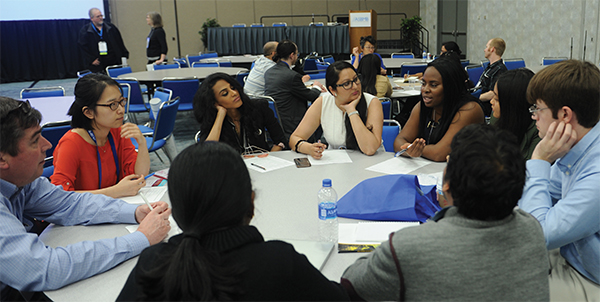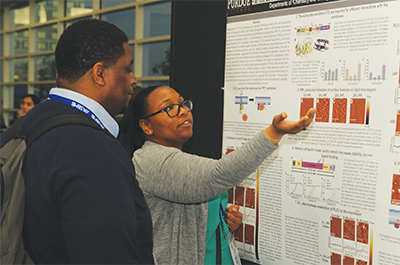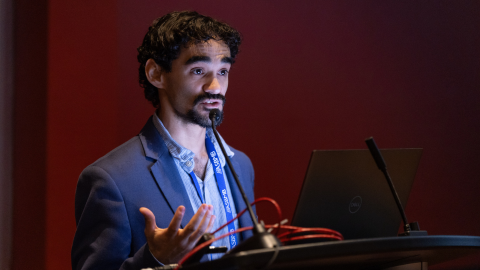How do grad students and postdocs choose conferences?
The first time someone asked me this question, I did not have an answer. Throughout my years of undergraduate, graduate and now postdoctoral fellowship research, I have been to many conferences, but I never thought about why I chose the ones I attended.
To gain more insight into my past choices and why I was now choosing to attend the American Society for Biochemistry and Molecular Biology annual meeting, I asked my colleagues why they attended specific conferences, what they thought of the ones they had attended and how much influence their mentors had over their decisions. Through these conversations, I began to understand their choices.
 The session on building your CV is just one of many offerings for trainees at the ASBMB annual meeting. This photo was taken this year in San Diego. ASBMB Fast forward to Experimental Biology 2018 in San Diego (of which ASBMB is one of the five host societies). I decided the best way to understand how conferences address the topics my colleagues had brought to my attention would be to jump in feet first, attend sessions and talk to other attendees to learn about opportunities I might have missed out on. Teaser: If you want everything in one conference, EB is the meeting you should attend.
The session on building your CV is just one of many offerings for trainees at the ASBMB annual meeting. This photo was taken this year in San Diego. ASBMB Fast forward to Experimental Biology 2018 in San Diego (of which ASBMB is one of the five host societies). I decided the best way to understand how conferences address the topics my colleagues had brought to my attention would be to jump in feet first, attend sessions and talk to other attendees to learn about opportunities I might have missed out on. Teaser: If you want everything in one conference, EB is the meeting you should attend.
My mentor told me I should go
This was the No. 1 answer I heard from trainees, and it is not a bad thing. Mentors have attended many types of meetings and can provide a mentee with new information. Conference decisions should include a dialogue between mentor and mentee to provide both parties with a mutually beneficial experience.
Side note to any mentors reading this: Please keep reading so you can share this information with your trainees, and remember, you have a strong impact on your trainees’ decisions. Trainees need to understand their goals in attending a conference. This can help the mentor and attendee navigate a daunting conference schedule to find the activities that best fit those goals.
Before I left for EB/ASBMB 2018, my mentor and I went over my poster dialogue to discuss the key scientific points I needed to convey. We talked about the scheduled speakers so I could begin to plan my days. And on my return, we discussed what I had learned, the feedback I had received on our project, and the people I connected with and reconnected with during the conference.
It’s small and intimate, which allows me to network
I know “Experimental Biology” and “small and intimate” don’t seem like they would go hand-in-hand. At least that’s what I thought before I attended EB 2018.
I went to the conference in what I thought was a mentorless state. It was not my first time doing this, but I had never attended a conference of this size.
When I arrived on Saturday, I was immediately welcomed into the ASBMB travel award recipient sessions. The morning included career-path seminars with advice from leaders in biotechnology, academic science, government and nontraditional tracks. Only trainees attended, so it was a more comfortable place to ask speakers questions than the general sessions. Also, these sessions took place before the start of the larger conference, so speakers were more available to continue one-on-one discussions.
Saturday afternoon was filled with interactive sessions on networking, resume building and interview tips and techniques, followed by panel discussions with the morning lecturers. Because many of these had similar themes, I got to know other attendees as I passed from session to session. I continued to run into many of these people throughout the conference. The ASBMB travel award sessions helped me make many unexpected contacts.
Without my mentor, I was nervous about the remainder of the conference. As I walked around alone, I noticed many laboratory groups. Some mentors had encouraged members of their labs to attend and also reached out to previous lab members who were attending. I have never seen such reunions at any other conference.
I always heard that at large meetings you are just one of many. This could not be further from the truth. Even without a mentor, I was never alone at EB. Members of my previous graduate department welcomed me into their lab groups. I ran into collaborators, graduate students I hadn’t seen in years and faculty members from my current university. When I walked into EB, I thought it would be impersonal, but I was met by old friends and colleagues in addition to making new contacts.
I want to hear and meet with high-profile speakers
EB and ASBMB are the best opportunities to hear top speakers in a multitude of fields, from the opening lecture Saturday evening through the last lecture on Wednesday. The ASBMB makes sure that its session organizers choose a diverse group of expert lecturers to share their ideas with the scientific community. And the ASBMB is committed to rotating speakers, so each year is a unique experience of hearing top-tier scientists.
In total, the 16 scientific sessions each include four speakers in the themed field, providing attendees an opportunity to pick from more than 60 top-tier scientists from around the world — and that’s just the morning sessions. The afternoon sessions offer many additional speakers, including junior faculty, postdoctoral fellows and students presenting research from their laboratories.
 In addition to poster sessions like the one pictured here, some grad students and postdocs at the ASBMB annual meeting get to present their work in Spotlight Sessions — and more opportunities to share research are in the works for 2019. ASBMBMy research has focused on lipid biochemistry, so I was excited to start the conference with a session on lipid signaling and metabolism. However, I was surprised when I was equally excited about a session on new insights into the links between metabolism and disease and one on advances in single-cell -omics. These talks might not have been part of a smaller, more focused conference, but they directly pertained to experiments related to my work.
In addition to poster sessions like the one pictured here, some grad students and postdocs at the ASBMB annual meeting get to present their work in Spotlight Sessions — and more opportunities to share research are in the works for 2019. ASBMBMy research has focused on lipid biochemistry, so I was excited to start the conference with a session on lipid signaling and metabolism. However, I was surprised when I was equally excited about a session on new insights into the links between metabolism and disease and one on advances in single-cell -omics. These talks might not have been part of a smaller, more focused conference, but they directly pertained to experiments related to my work.
The ASBMB not only provides an opportunity to hear experts but also to meet them after their lectures. During the conference, I heard a lecturer state that approximately 75 percent of scientists are introverts. I — an extrovert — appeared to be the odd woman out. If I wanted to meet a speaker, I would seek them out and talk to them. Most of my peers were uncomfortable doing this, thus making the “Meet the Speakers” sessions truly exceptional. I attended a few of these sessions and was able to have one-on-one conversations with lecturers, including Kim Orth, the ASBMB–Merck Award winner. We spoke for about 15 minutes on topics ranging from her work over the years to choosing career paths. She was very cordial and willing to share her career experiences. All the lecturers attended these sessions and seemed equally engaged in conversations with trainees at all levels.
I want to network, I need career advice, or I want to meet people working in alternative careers
All of us know your network never can be large enough, and we all need a little career advice from time to time. I have never attended a conference that provides so many opportunities to learn about alternative careers and talk to people in those career paths and that also provides educational seminars on how to obtain those positions. In addition to the Saturday sessions for travel award recipients, the ASBMB ran a series of career development workshops throughout the conference.
Along with all the ASBMB programing, EB had an entire area dedicated to career development resources. There, you could practice presentations with experts who gave feedback and critiqued your CV. You could visit the job board or attend any of the educational seminars hosted by experts in particular topics. These small-group sessions were capped at 40 people, which made it easier to ask questions.
Through attending the sessions and workshops, I learned about the advanced grant-writing process, such as how to write and obtain a K99/R00 award; I attended sessions run by individuals who made the transition from academics to industry; and I went to workshops that made me reflect on all of the skills I have without even realizing I have them. Through these workshops, I gained an understanding of what I most value in a career: constructing and asking interesting scientific questions (grant writing), sharing my knowledge and mentoring younger scientists, and working as part of a team to accomplish goals.
I want to present my work
Most conferences, especially small ones, offer only poster session slots to graduate students and postdoctoral fellows. The ASBMB has made it a priority to schedule Spotlight Sessions with 15-minute talks, many of them given by trainees. Over the three-day conference, more than 100 trainees gained experience in giving oral presentations.
The ASBMB plans to expand speaking opportunities for trainees by adding short poster preview presentations on selected abstracts. These “flash talks” will be judged by a small panel, and feedback will be provided. The talks will give even more trainees the experience of presenting their work to a large audience, including some of the world’s top scientists, and will highlight their work to relevant scientists who then can seek them out for discussion. It also will help attendees find relevant posters in the poster hall sessions.
I want food, fun and free stuff
All joking aside, we’re all human and the reward pathways are strong in us. EB covers it all, from great conference locations to the many receptions with free food and drink and the 233 vendors giving out headphones, candy, toys, T-shirts and more. At most conferences, you’re lucky to get a pen and some paper. EB, and especially the ASBMB, goes out of its way to make sure you have a full conference experience up through the last day.
EB was an amazing experience for me scientifically — I heard some of the top scientists in the world — but also for career development, networking opportunities and the ability to share my work with a diverse group of scientists. I can say for certain that I never before had attended a conference that not only met but also exceeded my expectations.
I’m counting the days until EB 2019 in Orlando. I hope I’ll see you there.
 Sarah Martin trained with Robert Murphy at the University of Colorado Denver Anschutz Medical Campus in lipid biochemistry and mass spectrometry. She is currently a postdoctoral fellow at the University of Texas Southwestern with Helen Hobbs and Jonathan Cohen.
Sarah Martin trained with Robert Murphy at the University of Colorado Denver Anschutz Medical Campus in lipid biochemistry and mass spectrometry. She is currently a postdoctoral fellow at the University of Texas Southwestern with Helen Hobbs and Jonathan Cohen.Enjoy reading ASBMB Today?
Become a member to receive the print edition four times a year and the digital edition monthly.
Learn moreFeatured jobs
from the ASBMB career center
Get the latest from ASBMB Today
Enter your email address, and we’ll send you a weekly email with recent articles, interviews and more.
Latest in Careers
Careers highlights or most popular articles

Upcoming opportunities
Apply for the ASBMB Interactive Mentoring Activities for Grantsmanship Enhancement grant writing workshop by April 15.

Quieting the static: Building inclusive STEM classrooms
Christin Monroe, an assistant professor of chemistry at Landmark College, offers practical tips to help educators make their classrooms more accessible to neurodivergent scientists.

Unraveling oncogenesis: What makes cancer tick?
Learn about the ASBMB 2025 symposium on oncogenic hubs: chromatin regulatory and transcriptional complexes in cancer.

Exploring lipid metabolism: A journey through time and innovation
Recent lipid metabolism research has unveiled critical insights into lipid–protein interactions, offering potential therapeutic targets for metabolic and neurodegenerative diseases. Check out the latest in lipid science at the ASBMB annual meeting.

Hidden strengths of an autistic scientist
Navigating the world of scientific research as an autistic scientist comes with unique challenges —microaggressions, communication hurdles and the constant pressure to conform to social norms, postbaccalaureate student Taylor Stolberg writes.

Upcoming opportunities
The countdown to #ASBMB25 is on! Visit our annual meeting website to start adding special sessions, keynote lectures, scientific symposia and more to your personal schedule.

